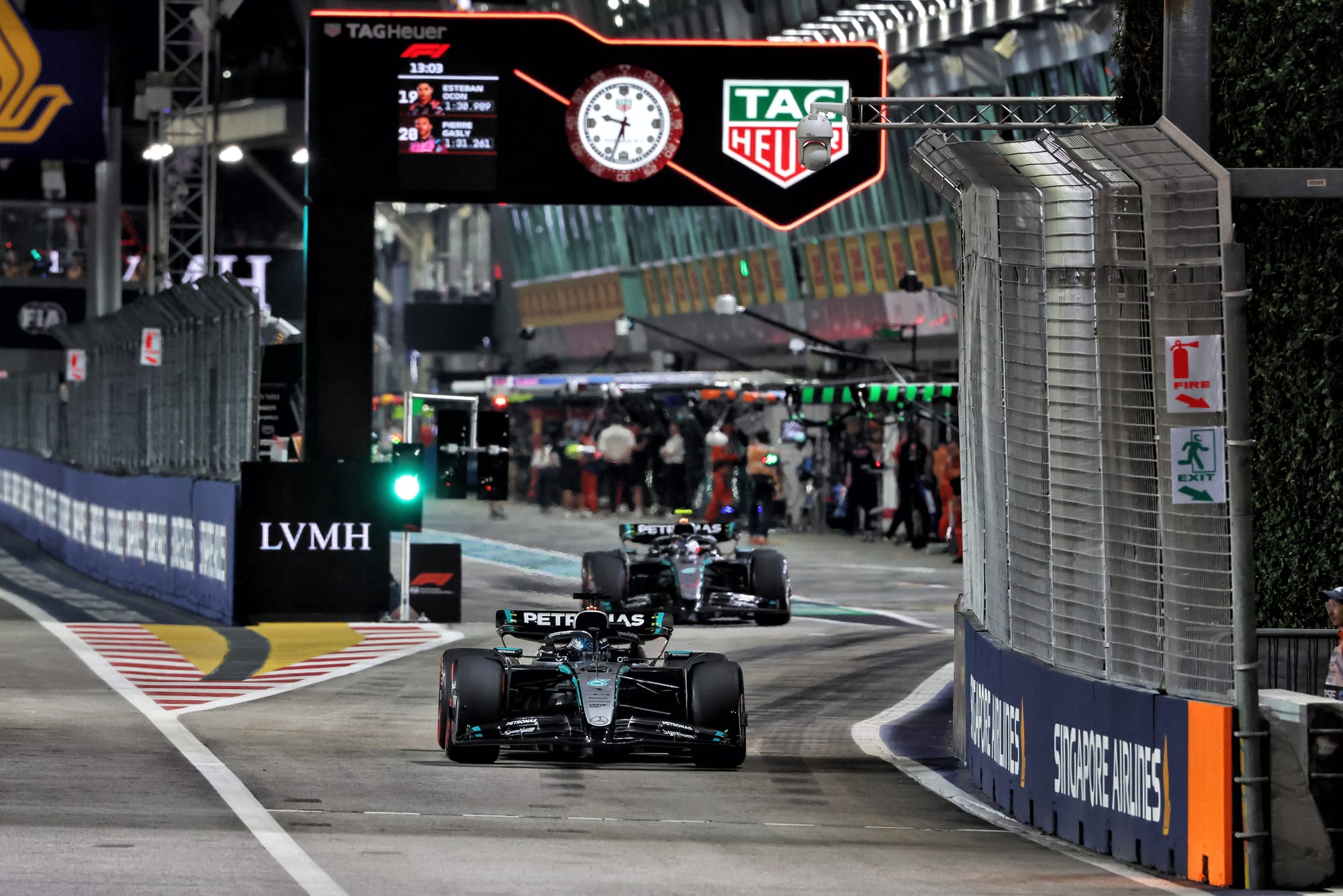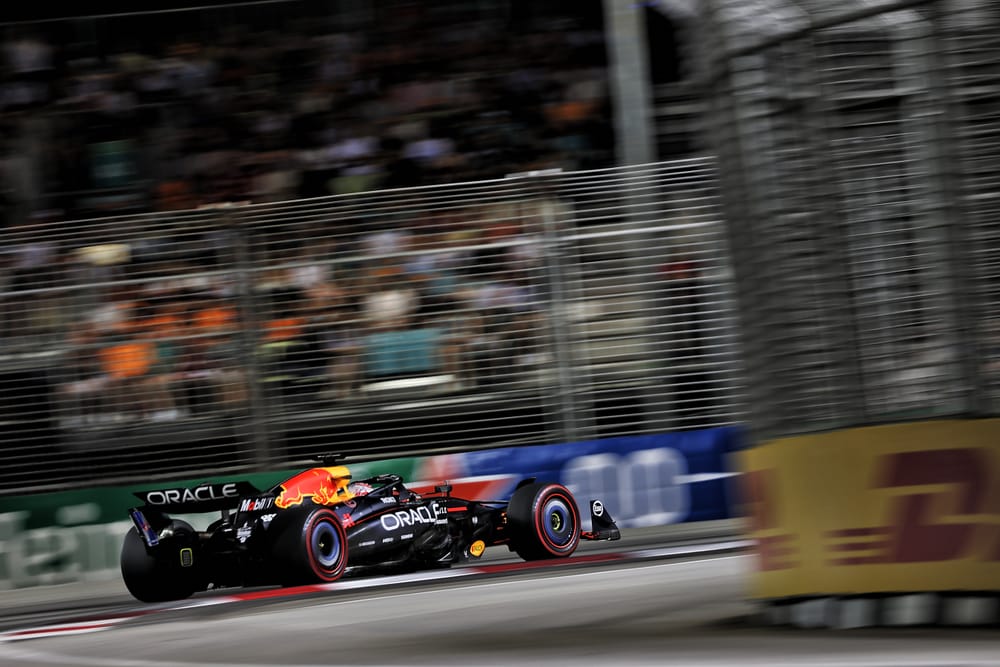The pole battle in Singapore Grand Prix qualifying was closely enough fought that it might have been decided by the dirty air of a car cruising back to the pits. That car was Lando Norris's but that's the only crucial part McLaren played in the 2o25 pole fight.
What stood as George Russell's pole lap in the Mercedes was within the sights of Max Verstappen, the last of the frontrunners to take to the track, trying to eke out every bit of surface grip as the night time temperatures fell and the rubbering-in of the asphalt increased.
As he began braking the Red Bull for Turn 16, the first part of the right-left chicane, Verstappen was just two-hundredths down with plenty of scope to turn that around in the final two corners. That's when he encountered Norris's dirty air - and the front of the car began running wide.
Verstappen knew in that moment he'd lost pole - and with no one other than Russell to beat, he abandoned the lap (leaving him second courtesy of his first Q3 lap) and gave his friend Norris an angry little fist of frustration as he passed.
He felt that Norris should have been quicker in getting back to the pits in the knowledge there were other cars out there…
So a few things to unpack here. Why did pole battle feature these two cars and not a McLaren (Oscar Piastri in the faster of them was a hefty 0.366s behind)? And did Norris's cruising back to the pits really cost Verstappen pole?
Taking the second question first, you may have heard claims that he was 0.15s up on Russell as he ran wide - and technically that's true. But it's hugely misleading.
If you take so much speed into a turn that you run wide, and you stop the clocks at that moment, then you are super-fast. But the time gained by going in so fast is absolutely destroyed by the time lost coming out off line.
So the claimed 0.15s he was briefly in front by (it was actually 0.206s at its peak) was absolutely irrelevant and just the consequence of understeering wide in the dirty air.
Which isn't to say that without Norris's presence Verstappen might not have been able to overcome the tiny deficit he was behind Russell on the Turn 16 approach. But he was absolutely not on a sure-fire comfortable pole lap. It was going to be super-close.
Which brings us back to the first question of why it was Mercedes vs Red Bull.
It was pretty clear on Friday that the big pre-weekend question had been answered: could the Red Bull's recent improvements allow it to be competitive away from low-downforce tracks like Monza and Baku? Resoundingly, resoundingly yes.
Still running more front wing area than any rival car, that front wing had been tweaked here to give enhanced outwash around the wheels - and almost certainly more flexible outboard tips, thereby reducing drag.
So suddenly the Red Bull's aero efficiency, even on a big wing track like this, was now competitive - unlike earlier in the season.
Secondly, the recent balance window Red Bull has managed to get the car into was absolutely still wide open here.
"It felt pretty much as it has for the last three weekends," said Verstappen. "So when we get to the track now it's just fine-tuning.
"Obviously some tracks are still going to be better or worse for us, but the basic car pace is now a lot more solid."
How Mercedes became a factor

As for Mercedes, it too had a revised front wing here but one which reduced the downforce produced, allowing the rear to be trimmed a little for a straightline speed boost while keeping the car in balance through the turns.
Go onboard with Russell on his pole lap and you can see how nicely progressive the front end is, getting the rotation without quite upsetting the rear.
It hadn't been this way for Russell on Friday when he'd hit the Turn 16 wall as a result of the rear's nervousness. But there was a way around that in the driving approach - as team mate Kimi Antonelli had been demonstrating.
The rookie was faster than Russell on Friday, as Russell freely admitted after setting pole: "I learned a lot from looking at what Kimi was doing yesterday."
When he combined that with his own strong parts of the lap, he was fully in the fight. The lowish track temperature (in the mid-30°Cs and falling) was also to Mercedes' liking. Antonelli ended up fourth, splitting the McLarens.
So an improved Red Bull and Mercedes, but also a layout which doesn't reward the McLaren's great virtue of tyre temperature control because of the low energy inputs.
That may come to be more significant in the race, but in qualifying it had no great advantage in that area.
"Also, we gain time mid-corner, as usual," said Andrea Stella, "but here every mid-corner is too short [for us].
"Here is dominated by brakes and traction and with bumps and kerbs on which we seem to suffer a bit.
"The drivers were making comments very similar to Baku and Canada, also tracks where we were not the quickest car, just as we are not here."
Piastri felt his lap was clean. Lando Norris, on the same tenth but two places back, was rueing the understeer balance he couldn't do anything about or with.
The limiting traits of the car around tracks such as this definitely seem to have been exacerbated by the change to a stiffer front tyre construction this year, as Stella suggested.
"There are some aspects of the new front tyres that we have this year - and which Lando has pointed out from start of the season when he was talking about it being difficult to get the feeling from the front of the car," he said.
"Last year around here our drivers were much more comfortable on this track. Right from FP1 this year they were making comments about the behaviour of the front tyres. This was less on hard and medium but definitely the case on softs."
There was definitely something a little different about how these 2025-spec stiffer fronts were interacting with the further resurfaced parts of the track. Verstappen and Russell mentioned it too. The track grip was high, but mid-corner the rubber was moving, giving a strange sensation.
At Ferrari, that problem was much more acute. Neither Lewis Hamilton (in sixth, 0.530s adrift of pole) nor Charles Leclerc (seventh, 0.626s off) could get anything like enough load into the fronts on the Ferrari.
For his final run, Leclerc put maximum front flap on in desperation and reported it made almost no difference.
There is still much black art amid all the science.



